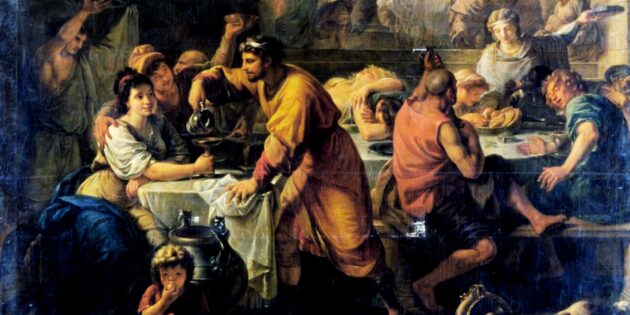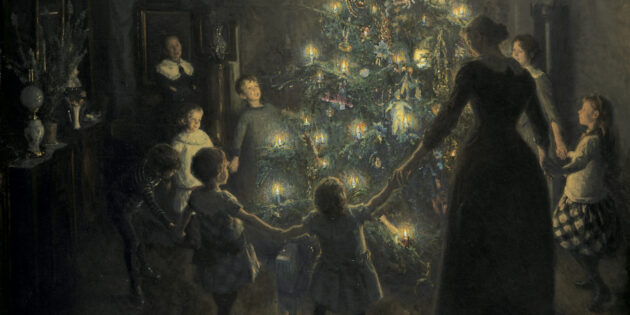If you Google it, you can find a lot of interesting things. In particular, there are stories that the ancient Celts (in other sources, the Germans) on the winter solstice offered bloody sacrifices to forest spirits so that they would allow them to survive the cold.
Young girls were allegedly killed, and their insides were hung on the largest Christmas tree in the forest as an offering to the forces of nature.
Over time, Christianity supplanted paganism and festive massacres were abandoned, replacing the torn organs with balloons and garlands. And only historians remember where it all came from.
However, no real evidence of the Celts or Germans using the digestive tract as jewelry has been preserved. No, they may have practiced human sacrifice J. Koch. The Celts: History, Life, and Culture , but infrequently and hardly in this form.
In addition, certificates Peter S. Wells. The Barbarians Speak: How the Conquered Peoples Shaped Roman Europe. Princeton University Press The bloodthirstiness of the Celts and Germans comes mainly from Roman historians, and it was advantageous for them to represent those as dangerous barbarians who can and should be exterminated as much as possible. In general, the opinion that New Year's garlands originated from the guts of victims tortured by pagans looks intriguing, but not very convincing.

There are also less bloodthirsty myths about the origin of the New Year tree. In particular, one of them says that it all started with the mentioned ancient Romans. They allegedly decorated their homes with evergreen trees during the celebration of Saturnalia, a festival in honor of the god of abundance Saturn, held from December 17 to 23.
However, if you read more about this holiday, it turns out that the Romans did not do anything related to Christmas trees then Macrobius. Saturnalia / Liber Primus . Drinking and feasting, yes. They fooled around and played games of chance, forgave all sorts of liberties to slaves, gave gifts and organized contests. But no Christmas trees were decorated.
The customs of hanging ornaments and gifts on different trees were found in different eras and among different peoples — including the Egyptians, Chinese and Jews. However, there is no evidence of any connection between them.
In Europe, various rituals with Christmas trees also existed. For example, it is known that in Tallinn in 1441 and in Riga in 1510, was installed on city squares Friedrich Amelung, Ferdinand Wassermann. Geschichte der Revaler Schwarzenhäupter: von ihrem Ursprung an bis auf die Gegenwart: nach den urkundenmäßigen Quellen des Revaler Schwarzenhäupter‑Archives 1, Die erste Blütezeit von 1399-1557. — Revel: Wassermann, 1885 Evergreen trees, danced around them, and then set fire to them for good luck. These actions are not related to Christmas or New Year — they were festivals of the guild of shipowners called the Brotherhood of Blackheads. This was how sailors celebrated the end of navigation season, when ships could no longer sail and they could rest.

But it is decorating the Christmas tree, and not burning it, that is a purely Christian custom, unrelated to pagan rituals. At least since the 5th century in Europe, on December 24, at Christmas, were held G. Blainey. A Short History of Christianity mysteries are plays accompanied by divine services. During them, the actors acted out scenes from the Bible — mostly related to the fall of Adam and Eve, the birth of Christ, his crucifixion and ascension.
For the scenery in these plays, was often installed G. Blainey. A Short History of Christianity the "paradise tree" from which Adam and Eve tasted the fruits of the knowledge of good and evil. He was hung with apples and consecrated wafers. There is evidence that since at least the XVI century in Germany, for church mysteries at Christmas, fir trees decorated with sweets — fruits and pastries, as well as lighted candles began to be installed in squares.
Until the 17th century, the Christmas tree was popular only among Lutheran Germans.
German settlers in the XVII century brought Christmas tree / Britannica it was sent to America, and in England it took root only at the beginning of the XIX century at the instigation of Prince Albert, the husband of Queen Victoria. Around the same time, the custom spread to Austria, Switzerland, Poland and the Netherlands.

I brought a Christmas tree to Russia New Year. The history of the holiday / GARF at the end of 1699, Peter the Great. Then he transferred the country to a new chronology and generally Europeanized as much as he could. The emperor ordered "some decorations made of pine, spruce and juniper trees and branches to be erected in front of the gate." "To the poor people, everyone should put at least a tree or a branch over the gate or over their house" and "fire three times and release several missiles, as many as anyone happens."
However, after Peter's death, the tradition was forgotten until 1828. Then Empress Alexandra Feodorovna, nee Prussian Princess Charlotte, ordered the installation of Christmas trees in the Anichkov Palace to refresh childhood memories of how Christmas was celebrated in her homeland. Her Majesty set the trend, and evergreen trees hung with sweets began to appear in winter in all noble houses of St. Petersburg‑St. Petersburg.
Naturally, people of a simpler background did not do this: They couldn't afford these noble entertainments of yours.
In general, in Russia, a limited number of particularly intelligent people put up Christmas trees The return of the Christmas tree / RGB until 1926 — then the Central Committee of the CPSU(b) considered this practice "obscurantistic" and "anti-Soviet" and decided to ban it.
And only a decade later, in 1935, the party leader Pavel Postyshev, in a conversation with Joseph Stalin, said The return of the Christmas tree / RGB that the New Year in the country of victorious communism has become somehow boring and it would be nice to make it more interesting. So why not bring back the banned Christmas tree? The Generalissimo agreed: "Take the initiative, make a proposal in the press, and we will support it."

On December 28, 1935, Postyshev published The return of the Christmas tree / RGB , in an article in Pravda, in which he wrote that the bans on Christmas trees were caused by excesses in the field, but in general, the tradition is good. So New Year's trees were rehabilitated and they began to be installed throughout the Soviet Union.
But in all countries, including the Russian Empire, a decorated Christmas tree was associated primarily with Christmas. In the Soviet Union, it became an attribute exclusively of the New Year — because religion was not in high esteem at that time. After the collapse of the USSR, the tradition of decorating a Christmas tree in post-Soviet countries has been preserved, and to this day it is impossible to imagine a holiday without it.